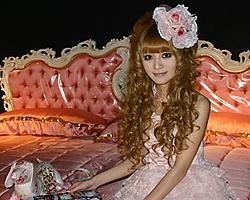The three girls walking down Meiji Street in the heart of Tokyo’s Harajuku district are talking loudly in cute high voices, sometimes breaking into giggles. They could be any group of teenage girls on a merry shopping expedition in the Japanese capital’s mecca of youth fashion — except for the fact that they are clad in clothing and accessories that mimic the look of comic-book heroines wearing the style of 18th-century princesses.
“My father asked me, ‘Where on earth are you going in that?’ ” says Mayuka Watanabe, laughing. She is a 17-year-old high school student sporting a headband with a big ribbon and three pink roses. Her friend Miki Takahashi, 18, who takes her fashion inspiration from Cinderella, adds, “People look at me and sometimes even point a finger at me. Once a little kid on the train looked at me and exclaimed, ‘Look, there is a fairy!’ which was kind of embarrassing, but I didn’t care because I just wear what I like.” Sanae Nagamine, a 21-year-old waitress from Hitachi in northeastern Ibaraki prefecture, had to take a two-hour train ride to join her friends on this pilgrimage to Jesus Diamante, one of the first fashion brands to promote hime-kei, as the look is known, with its frilly pastel frocks and ringlet hairdos. With money earned from part-time work, the girls plan to shop for two hours at the brand’s Harajuku store before heading to its Shinjuku branch. “I love their design. It amps me up!” enthuses Nagamine.
Hime-kei appears to have been inspired by American filmmaker Sofia Coppola’s movie Marie Antoinette, with its lush rendering of the decadence of the court of Louis XVI. The rush of young Japanese women to emulate the look of 18th-century French aristocrats has grown from a fad into something of a movement, whose leader is the popular singer Ayumi Hamasaki. It even has its own magazine, Koakuma Ageha, with a circulation of 350,000. If Coppola’s movie created the wave, Osaka-based Jesus Diamante was ready to ride it. Established in 2001, the label had offered luxurious clothing styled for a hypothetical heiress with a likeness to French actress Brigitte Bardot. But the impact of Marie Antoinette prompted it to introduce such lines as Marie Wanpi, with a ball gown sporting a large ribbon on the chest and a Cinderella coat with a fur collar and sleeve edges.
Takatoshi Imada of Tokyo’s Institute of Technology, Value and Decision Science sees hime-kei as a response to an unsatisfying way of life. “The hime-kei girls removed the borders between the virtual and real worlds,” says Imada, who believes the phenomenon is rooted in a rejection of the goals of advancement through hard work in an ailing market economy. “They longed for a different form of self-expression and sought a more meaningful way of life.” Searching for meaning through the fashions of a doomed European aristocracy may be a form of protest against a business-driven contemporary Japanese culture, but it’s certainly made healthy profits for the Jesus Diamante label. Today, the company runs four stores; by mid-2007 it had earned more than $14 million from selling dresses that run from $500 to $600 each and coats that cost up to $1,500. The average client spends $1,000 a month in support of her princess habit — but some spend as much as $4,000 a month. Most clients are girls in their teens to mid-20s, but there are some women in their 30s and 40s who wear the look.




